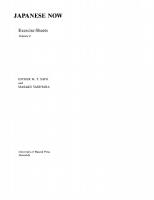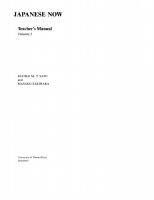Japanese Now: Text — Volume 1 9780824840297
123 33 19MB
English Pages [124] Year 2023
CONTENTS
PREFACE
INTRODUCTION
NOTE ON PRONUNCIATION
INTRODUCTORY UNITS
INTRODUCTORY UNIT 1
INTRODUCTORY UNIT 2
INTRODUCTORY UNIT 3
INTRODUCTORY UNIT 4
INTRODUCTORY UNIT 5
INTRODUCTORY UNIT 6
INTRODUCTORY UNIT 7
INTRODUCTORY UNIT 8
INTRODUCTORY UNIT 9
LESSONS
LESSON 1 Jiro Meets Tom
LESSON 2 Deciding to Go to The Beach
LESSON 3 Deciding to Go to McDonald's
LESSON 4 Deciding What to Have for Lunch
LESSON 5 Jiro and Tom Decide to Go to the Movies
LESSON 6 Jiro Prefers to Study for the Test
LESSON 7 Jiro Buys a Birthday Present
LESSON 8 In the Morning
LESSON 9 Preparing to Go Swimming
LESSON 10 Jiro Plans for a Date
LESSON 11 Jiro Meets Mary on a Date
LESSON 12 Jiro and Mary at the Zoo
LESSON 13 Lunch Time at the Zoo
LESSON 14 At Jiro's Home
LESSON 15 At the Department Store
LESSON 16 Caught in the Rain
LESSON 17 After Returning Home from Shopping
LESSON 18 Going for a Walk before Dinner
LESSON 19 Father Returns Home from Work
LESSON 20 Planning for an Outing
APPENDIXES
SUMMARY OF GRAMMAR
LIST OF KANJI
LIST OF VERBS
GLOSSARY
ABOUT THE AUTHORS
MAP OF JAPAN
HIRAGANA CHART
Recommend Papers

- Author / Uploaded
- Esther M. T. Sato
- Loren I. Shishido
- Masako Sakihara
- Jean M. Sakihara
File loading please wait...
Citation preview
JAPANESE NOW Text Volume 1
ESTHER M. T. SATO LOREN I. SHISHIDO MASAKO SAKIHARA
University of Hawaii Press Honolulu
COPYRIGHT © 1 9 8 2 BY THE DEPARTMENT OF EDUCATION, STATE OF HAWAII ALL RIGHTS RESERVED PRINTED IN THE UNITED STATES OF AMERICA
01
00
99
98
97
96
13
12
11
10
TAPES TO ACCOMPANY THIS TEXT ARE AVAILABLE FROM UNIVERSITY OF HAWAl'l PRESS 2 8 4 0 KOLOWALU STREET HONOLULU, HAWAl'l
96822
Library of Congress Cataloging-in-Publication Data Sato, Esther M. T„ 1915— Japanese now. Contents: v. 1. Text. 1. Japanese language—Text-books for foreigners. I. Shishido, Loren I., 1946II. Sakihara, Masako, 1935. III. Title. PL539.3.S28 495.6'82421 81-23142 ISBN 0-8248-0773-1 (vol. 1) AACR2
University of Hawai'i Press books are printed on acid-free paper and meet the guidelines for permanence and durability of the Council on Library Resources
CONTENTS
Preface
v
Introduction
vii
Note on Pronunciation
viii
Introductory Units Lessons
1 11
Lesson 1 Jiro Meets Tom
13
Lesson 2 Deciding to Go to the Beach
15
Lesson 3 Deciding to Go to McDonald's
19
Lesson 4 Deciding What to Have for Lunch
22
Lesson 5 Jiro and Tom Decide to Go to the Movies
26
Lesson 6 Jiro Prefers to Study for the Test
29
Lesson 7 Jiro Buys a Birthday Present
34
Lesson 8 In the Morning
37
Lesson 9 Preparing to Go Swimming
40
Lesson 10 Jiro Plans for a Date
45
Lesson 11 Jiro Meets Mary on a Date
48
Lesson 12 Jiro and Mary at the Zoo
51
Lesson 13 Lunch Time at the Zoo
55
Lesson 14 AtJiro'sHome
59
Lesson 15 At the Department Store
63
Lesson 16 Caught in the Rain
67
Lesson 17 After Returning Home from Shopping
70
Lesson 18 Going for a Walk before Dinner
73
Lesson 19 Father Returns Home from Work
76
Lesson 20 Planning for an Outing
80
Appendixes
85
Summary of Grammar
87
ListofKanji
91
List of Verbs
93
Glossary
95
About the Authors
111
Map of Japan
112
Hiragana Chart
114
PREFACE
Language learning is an essential component of general education today. The series Japanese Now was developed with the belief that in an increasingly complex and technologically advanced world general education must encompass a realization and appreciation of the necessity for mutual interdependence and peaceful coexistence among all peoples and nations. The study of languages and cultures provides students with a means to know and understand their fellow citizens of the world. This series will introduce them to the Japanese and give them valuable insights into how the Japanese communicate and meet daily challenges and human needs. The four volumes of this series are designed to serve as the basic unit of a four-year high school Japanese language program. In a three-year program, volume 4 may be used as a reader for advanced students. Volume 1 focuses on the individual and her friends and gives the student a basic vocabulary of useful words and expressions. Volume 2 acquaints the student with his immediate surroundings, including the family and the neighborhood. Volume 3 leads the student into the larger community and introduces him to Japanese literature and art. Volume 4 takes a broad look at Japan, its cities, history, religion, and its political and economic life. All four volumes are intended to teach language and at the same time expand and deepen the student's understanding of various aspects of Japanese culture. The differences between colloquial and literary Japanese are clearly indicated. Students are first exposed to the spoken language as it is used daily in various social contexts, and are familiarized with the basic structure of Japanese as well. Later, the formal written style is introduced. Students will be able to contrast and compare the two styles readily. Many people have helped us directly and indirectly in making this series a reality. The administrators, teachers, and students of the Hawaii State Department of Education have supported our efforts throughout. Without their cooperation, encouragement, and assistance, such a project would never have been attempted, much less realized. Loreen Ige, Joanne Kanda, and June Kuwabara of Castle High School, Howard Asao of Farrington High School, and Fumiyo Yamanaka of Waiakea High School used and tested our materials and made invaluable comments and suggestions for improving the final product. To the Reverend Eijo Ikenaga goes our warmest gratitude for his creative artwork and calligraphy. At the University of Hawaii, our special thanks go to the administrators and our colleagues in the College of Education, particularly those in the Department of Curriculum and Instruction and the Research and Development Group, and to colleagues in the Department of East Asian Languages: David E. Ashworth and Takako Ayusawa, who helped with editorial tasks, and Kyoko Hijirida, who assisted with the preparation of tapes. To the University of Hawaii Press, we say "mahalo" for the help and guidance we received throughout the publication process.
INTRODUCTION
The Japanese language is spoken by more than 120 million people in Japan proper and a few million more in Okinawa, Korea, and some islands of the South Pacific. Some sixteen centuries ago, the Chinese writing system was introduced in Japan and has since been used with the Japanese syllabary, which was developed in Japan. The Japanese language has many dialects, but since the Meiji Restoration in 1868, standard Japanese has been based on the Tokyo dialect. Today, the Tokyo dialect is the language spoken and understood by the majority of the people of Japan. This series is designed to enable the student to learn Japanese by listening, speaking, reading, and writing from the beginning. No romanization is used. Students learn to pronounce and recognize the Japanese syllabary. Introducing the syllables and symbols reinforces and accelerates the language learning process. In addition, students are more likely to develop a " p u r e " pronunciation through the use of the syllabary, and will learn kanji more readily. Nine introductory units provide a basic vocabulary of everyday words and useful expressions that allow the student to begin speaking Japanese immediately. Grammar and grammatical structures are not discussed in these units. While students practice greetings and basic conversations, they also practice reading and writing the kana syllabaries. The major objective of this series is to develop not only oral fluency, but an overall competence in Japanese, which also includes insights into the cultural context of the language as well. Thus, the material presented covers all facets of Japanese life and is keyed to topics relevant to students' interests and related studies. All four volumes have Japan as the setting and build lessons around various situations and episodes that will help the student to understand and appreciate Japan and the Japanese.
NOTE ON PRONUNCIATION
Japanese is a syllabic language. It is made up of distinct syllables which have the same sound duration. Five syllables are vowels that may be short or long with the long given twice the sound duration of the short vowel: It is important that a clear distinction is made between long and short vowels. ¿¡9 resembles a in father, but is much shorter; fa $> is like aah. I ^ is equivalent to i in mach/ne, but shorter; o u sounds like eek. •y resembles ui in suit, but is pronounced with unrounded lips; < n is like cool. is the same as e in get;
I * or A. A. is like eeh.
to is pronounced like o in obey; fc n or fc & is like ooh. ^ is pronounced like n in by
, ii\ l i
f
when it is followed by tz,
b , tz f 5 V>
hot
good
white yellow
Adjective + Noun L 5 0
red shoes
Z A/CD
9
Note: numbers refer to entries in Grammar section. II. D I A L O G U E tz&fr
:
T
:
fr)
h A •
o
tzüfr : 7iit>
:
tztafr :
t z ü f r Z A , (i? t
7
9 § «fc 9 T * 1 " o
III. V O C A B U L A R Y
(tz/uZ) Japanese name for a male. (In Japanese the last name comes first followed by the first name.) (Particle connecting two nouns.)
CO
am, is. (Depending on the context, am, you are, he/she is, it is, or they are.)
can mean
/
Tom Akau. (Katakana is used to write a foreigner's name, with first name first and then the last as in English. A dot is placed between the first and last name.) j;6L
h
socks handkerchief only that what this
iti
whose 5 5
my father. (Used to refer to speaker's father when speaking to someone outside of the family.)
ttliïtt
that's all that's right
SUPPLEMENTARY
VOCABULARY that one over there tower which what language? 34
IV. 1. Z t i l t
M ^ t ^ o
What is that?
Both &A/ and mean what, Ax is used before words which begin with the sounds t, d, or n, and also in a compound word designating how many. Ex.
&
What did you buy?
k A £ 2.
Zflthis',
£
H ^ l f c i » ,
^ f t that',
fofi
What and what did you buy?
that over there", ¿f f t
which
Z f l indicates something close to the speaker, - f f l refers to something close to the listener, and fofi something at a distance from both the speaker and the listener. E t i is a question word. These words are demonstratives used to point at or refer to a thing or things. 3. < O L f ; { :
mv ^ f t t o
I bought socks and handkerchiefs.
In this context, the verb is understood to be replaces fr O Ltz0 Ex. Q:
Ltz
Ltzfr„
A:
^yiJ^f-
and need not be repeated. Here "Ct" What did you buy?
I £ 1
I bought socks and handkerchiefs. f t ,
4. • f t L ^ i i T - f ^ o
Is that all you bought?
/ f i t is a particle meaning only.
V.
DRILLS A. Question-Answer: Use of Z f i and
ft . Cue: 7 ° U - t f > h
Q: A:
ztui
1.
U - y
^ n f ^ h - e t .
2. 3. of
¿1 Jt V
4.
fc^fa
5.
fctL
6.
fotl Cue: H&9
Q: A: 1. f - V * - h 2. 3. 4. 35
J^yii f-
C. Answer the following questions using fc i t Ex. Q:
. Cue:
o
only a book
A: l i / v t z i f e i " o 1. 2. t z ï l i ï 3. i O l : ^
(only Mr. Tanaka)
èÉLfcsô»o n i t i
1
.
(only Tom and Jiro)
Lît/v^
(only today and tomorrow)
D. Construct questions to the following answers Ex. A: *>*>*-?1*o fc^lîJ:? o
800,000
10,000
iztA,
"5 ^ Ax
-
100,000
^ Ax
20,000
900,000
30,000 TIME
40,000
A/
< £ A,
1,000,000
(E)
&Ax Li
W h a t time is it?
L-^i;
7 o'clock
1 o'clock
ft*> Li
8 o'clock
2 o'clock
< t;
9 o'clock
3 o'clock
Li tg> 9 Li
ii;
4 o'clock
Li Kb 9
ri;
5 o'clock
li (9> 9 i - Li
5< U
6 o'clock
iii;
YEN -
10 o'clock Li
11 o'clock 12 o'clock
;lAx
X>* < A A,
100 yen
K t t * < *Ax
200 yen
5,000 yen
c? A x t » < £ Ax
300 yen
6,000 yen
J; Axi>->?
< h
how much? airplane dollar 73
b A < / U i
IV. - 5 ? M S " 9 1. HD? L «k < ¿ T .
I have time until dinner,
i t * is a particle which means until or up to a certain time, event, or place. Ex.
O i t t o t>tz
to the informal past.
• --k^tzh
ft n Z. 9
if p fc 6 ?
Why don't you go to school?
?
Why don't you eat lunch?
2. ^ 9 7f
fao
Yes, maybe.
tz is the informal or plain form of situation.
and is usually used by a male speaker in an informal
f ^ T ' t f e (formal) •f 9 tz
fa
(informal)
3. i J Z ^ o
Is that so, okay.
is omitted in this expression. It is used usually by male speakers in an informal situation, (formal) 9 ^
(informal)
V. D R I L L S A. Give the formal form of the following phrases. Ex.
Aofce?
1. ifi^ZoK 2.
9
r
o
T
5
Ao£e> .
^
3. < t 0 £ 4.
i
ts&6tz
Z(Dli/o£
£/utzt>?
7. K&A/zr-e
zitnizh?
6.
tk^is^? ^fcfc?
8. 77
VI.
REVIEW A. Say the following in Japanese. Ex.
father's birthday
1.
mother's car
2.
older brother's girlfriend
3.
Japanese car
4.
Japanese language book
5.
English book
6.
American television
B. Substitution 1. Ex. Cue:
Japan
1.
America
2.
school
3.
3 o'clock
4.
here
5.
Hokkaido
A t T*
2. Ex: Cue:
Hawaii
1.
school
2.
5 o'clock
3.
there
4.
bank
5.
railway station
3. Ex. Cue:
home
school
1.
Hokkaido, Kyushu
2.
Tokyo, Honolulu
3.
Japan, Hawaii
4.
here, there
5.
3 o'clock, 5 o'clock
C. Repeat Review Drill B.3 and complete the sentences with an appropriate verb.
Ex.
VII.
enter
/
KH Li
¿c
L E S S O N 20
Planning for an Outing
Situation: Family conversation I. R E A D I N G SELECTION t.«fc-5fi
±®0T*to
isltZ/ob
fîtt-to
fc^è/^a*
b&tzto
'Î-TJ-IZ
o < 0 i t fîËÉt^Ç),
F^M^f::
fît il.
^ o è fc'lHè^o
h A
tr-;uT*t^o
h A
t£
o
t C
l i
(Noun) ¡ i
i ^ T ' t
(noun)
4. 9 * > f i
is; am; are
5.
Question marker -
6.
X t
Omission of the topic/subject
fc&tf»
7.
Omission of words other than topic/subject
?
LESSON 2
1.1X>tXt&
Time words
2. tzts.fr
Particle i ;
3. Word Order Particle
4.-9*5^ 5. O f 6.
f t
^
Nonpast formal form of verbs Verb negative + fr
P I M M !
Particle fa
7. 8. O f
t L
Tentative form of verbs
«k 9
LESSON 3 1.
K^A- F t
2.
fc^ii"
Particle
t z ^ t t
Particle
3.
fcttSfi?
/jor^r
4. Word Order: Topic/subject + location + action
LESSON 4
tz'< & Ltz
1. 2.
Formal past tense form of verbs
- X K tz £ ^^ please do;
O T O ^ l 1 1
3. 3
Particle ( I ;
OT
AxtLK^l
fr
Xt*t r >) -i 7
f
Eg
U i t A,
l t
t
free time
IU 4, 2
one hundred. (Counter for hundreds.)
9
hiragana
IU 3, 19
tett
(fc-5)
(Diitf
frb^^tz
¿f 9
Hokkaido — northernmost Japanese
15
island * y
Honolulu
1
book
IU 3, 17
iS/vL^ ?
Honshu — main Japanese island
15
IS. A, b o ?
really?
15
l i f u b - 9 ¡1
really; truly
14
fS A^ ¿r
actually
11
every day
IU 5
before; to
12
McDonald's
3
-t L i 9
(Verb suffix to express let!s.)
3
-^"t"
(Formal nonpast verb suffix.)
3
-i-ftA,
(Formal nonpast negative verb
3
* 1
ii
^ X.
suffix.) £ tz
not yet; still
3, 16
^ t t b i i d
let's wait
16
iloTOii*
I am waiting
13
i f
until ten thousand. (Counter for ten thousands.)
18 9
$ —t 4 y
meeting
9
short
iu 8
water
IU 2, 14
lake
2
swimwear
9
< /£ £ V
please show me
17
1
shall we see . . .
5
to see
3
milk
16
barley tea
14
¿".-(fci l i l i ^
(MS) tft'^^
106
difficult
IU 7.
trouble; inconvenience
13
Mary
10
é
also; t o o
9
è -5
already
8
Thursday
20
^ T P t i t
to take (thing) along
14
&
Oh boy!
17
Waikiki
5
understand
IU 4
I don't understand
IU 9
I forgot.
IU 9
I; me (Both masculine and feminine.)
4
not good
13
(Subject marker.)
4
but. (Used to connect two statements.)
11
girl friend
14
school
IU 1,
give it all you've got; hang in there
6
g/oZ?
bank
15
M B
Monday
20
entry way to a Japanese home
19
1
P.M.
13
r-tfx
A.M.
13
£
five
9
=E pa
language
20
May 5th
20
Thank you for the meal.
IU 4
meal; cooked rice
IU 2,
Excuse me. (Used when announcing oneself.)
IU 8
golf
10
approximately (time)
9
magazine
6
too bad; it was unfortunate
4
(Counter for time.)
9
hour; time; period
2,9
isn't; aren't
12
tottitLfc btz
< L
• r s * 9 s £ (-e L fc)
£
s o
108
12 -f ¿>
well . . .
2
+
ten
9
eleven
9
juice
6
twelve
9
ten minutes
12
o
n
19
skillful
20
You're mean, brother.
18
- f V ^ ^
a lot
12
fz^EZ.6
kitchen
19
tzfrb
that is why
17
only
7
tzbb
no good
6
fzti
who
4
tzfKD
whose
7
X"
at (a place)
3
"C
by means of
9
T
and. ( - T f o r m of t - t . )
20
i? j . — J\
1
p
r
e
p
a
r
a
t
i
U «k 9 "f 6 9 Clt^A/tf)
O 12 to 3
T—
h
date
6
•et
tbtz
it's completed; it's ready
20
isn't it; probably
6, 9
it is; they are. (Comes generally at the end of a sentence after nouns or adjectives.)
1
•TS^— h
department store
3
T£>
but
6
tr h L
electric train
9
X/vfo
telephone
IU 4, 6
if 9
how about . . . ?
10
if 9 O tz L t t T
D o n ' t mention it.
IU 5
Eo
What happened?
16
H^X't^
H o w a b o u t it?
20
¿ * H T
why?
6
if "5
please. (Used when offering
14
T'Li?
LtLtz
something.) if 9
£ A/
zoo
11
if 9 £
thank you; I'm sorry
IU 6, 14
if 3.
where
1
if L * & 0
downpour
16
109
±WB K7A
h )
* U—
tf —
fcf-;u fcf 7 f
- 7 7 ^
y - ^ > y
4
-
110
Saturday
20
(go for) a drive
20
dollar
18
which
7
bus
15
bus stop
15
basketball
9
volleyball
10
beer
17
art
9
Big Mac
4
grammar; structure
1
not especially
5
study
IU 2, 3
box lunch
20
I; me. (Masculine usage.)
4
parking
15
party
20
piano
9
swimming pool
2
present
7
pen
6
french fries
4
ABOUT THE AUTHORS
ESTHER M. T. SATO, professor of education in the College of Education at the University of Hawaii, teaches foreign language methods and coordinates the student teaching program for foreign language majors. For more than fifteen years, she has also served as the liaison officer between the Hawaii Department of Education and the private Japanese language schools. MASAKO SAKIHARA has taught Japanese at the University of Hawaii and, since 1979, at the University of Hawaii High School. LOREN I. SHISHIDO also taught at the university laboratory school, at both the elementary and secondary levels.
Ill
SEA OF JAPAN
Kagoshima
PACIFIC
OCEAN
ZT L^ If r
If ^
tz ^
$
fr ^
^
£
if
If &
if £ ab
a* *
fc
>
i±
&
£
if
&
£
if &
&
fc
S
¡6»
&
&
*
-7
fotz/v
fc
£
¿fe •9"
iJ
T
K
L
t
O
¡1
L
t
O
*
>r
*
t
i 9
& fc
hj
frtzfrti
£
\>
1; 0
¡T
tr
?
V
¿i
0
•f
§
WJ) tf
J,
J&
t
tf 9 9
& 9
to 9 -9 9
t 9
< 9
9 9
5 cfc 9 jo A/
y
;u
A
7
^
7,
*
t>°
9
^
9
if
T* -tf
tf
'J
ti
¿6
u
^
£
£
ir 9
E
9
•f 9
K
y"
£
*
—
fc
-tf
(3T i?
t>
0
*
-e "t?
X
9
t
1;
t>°
9
P. *
A, ¿r
^
¡r tr r f tr g a t? ¡r t* ¿ ¿ ¿ ¿ ¿ ¿ ¿ ¿ ¿ J ; 9 9 9 9 * 5 9 9 9 9 9
£ i: i. J: i: • 5 9 9 9 9 if
e
9fcA/
9 9
X
69
«k 9
¡5 ¿0 & 9 9
V
3
y
9
fc/fA,:
TLX.-,
fcfco;
1
¿ f c o ; ¿fcO;
% «k 9 fcA,
if
T
•tr
y
X
frtzfrti.
t
*
T C—
fc
ivtz/v
t
%
9
9
% J; 9 fc 9 fcA,
h
V
3
*
9
Katakana J; 9 fcA, is expressed by '—' or '|' For example, n — k: — ; -tr — ; -1 Exceptions to "£>J:9fcA/ tl £ %.tzk,\
•a- if
X \^
«k
Jo A/
I
¿fc
Limited Usage £ is used only for the object particle in a sentence. a . is pronounced sentence.
when used as a particle in a
i i is pronounced b when used as a particle in a sentence. O and V in small letters followed by fr , tz , ( i f
L
t *
è
& &
i>
•V
t •Y
•v
f-
9
t KD % £ 9 9 Ìò/v
a.
f" J.
SL
Kb
tf Kb
f: KD
tf
tf Kb 9
U Kb 9
t? Kb 9
KD 1fl> 9 9
tf Kb 9
ÌC
U ji
-s j.
JL









